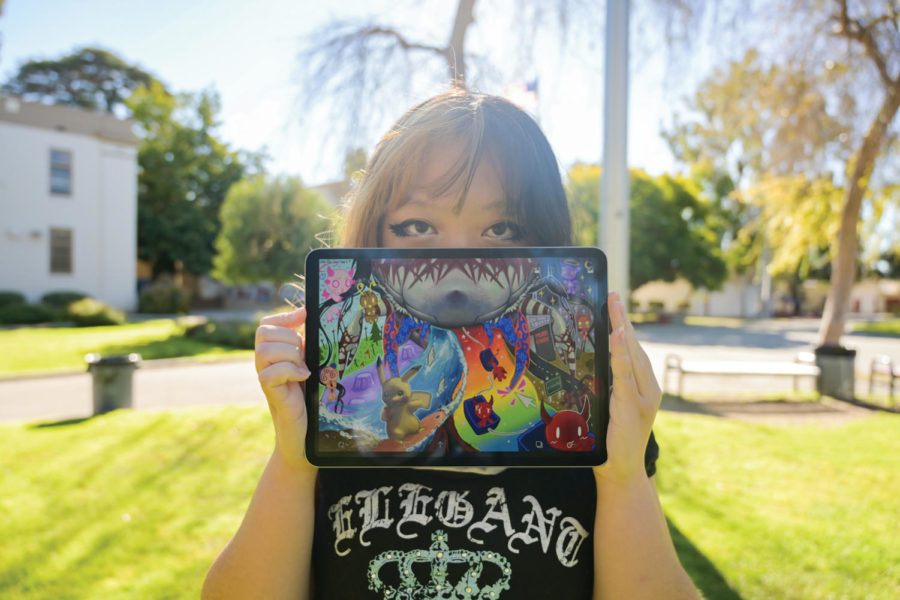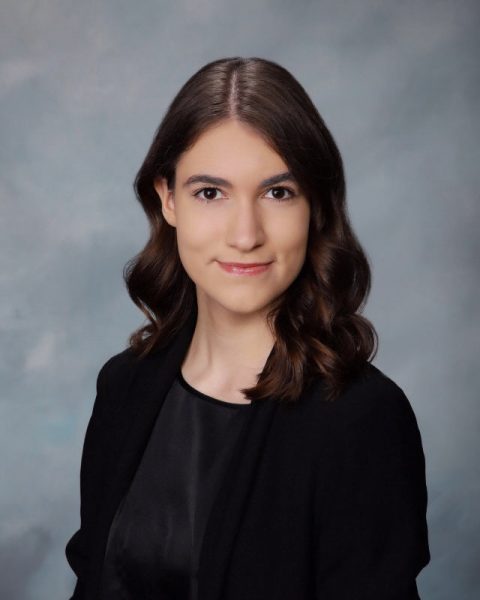The abridged version of this article appeared in the Feb. 2023 print edition of The Mirror. This is an uncut version.
A blank white canvas. Stark, bare and expressionless.
In the hands of a technically-skilled individual, it has the potential to be sculpted by delicate sketches and glazed with colorful brush strokes. In the grasp of an artist, it can be flooded with complexity, emotion and interpretation.
“I pull out a massive piece of paper and just start sketching ideas, especially for character design,” senior Ava Azarmi said. “There will be five good things out of a hundred sketches, and it’s just going to be an ugly mess of a paper. And then once I have that, I can start developing it digitally. It just goes from an absolute mess to a refined, and hopefully somewhat successful, masterpiece.”
With a range of work spanning from classical figure drawings to character and background designs catered to pre-production animation, Azarmi incorporates modern western animation and a touch of surrealism to design all the aspects of an animated story.
Since the age of nine, she has amassed a massive stack of sketchbooks containing her artistic pieces, some completed to perfection and others mercilessly scrapped. Azarmi attributes her early artistic growth to watching “how to draw” videos on YouTube.
She made up her mind to pursue art after taking an Intro to Computer Animation summer course at California State University Northridge when she was eleven.
“The teacher on the first day walked in, didn’t say a word and pressed play on the TV they had at the front of the room,” Azarmi said. “And I watched ‘Steven Universe’ ‘Mr. Greg.’ This episode of ‘Steven Universe’ is almost like a musical, and I saw that it integrated music and acting and obviously beautiful art and beautiful characters. I was very drawn to that because it integrates all of the artistic things that I like beyond drawing.”
Since then, she has been working tirelessly to improve her skills.
Senior Rosa Canas-Valadez, another young artist, creates artistic pieces based in realism and cartoonism and excels in constructing profound shapes as well as realistic structures.
Seventh grade is when Canas-Valadez made the decision to elevate her passion for art into a career path, and for six years now, she has been attending classes at Drawn2Art, an art studio in Northridge.
“I always found art really fun,” she said. “And I thought well, if I have to work, I wanna do something fun.”
She is often influenced artistically by her original characters, and loves to bring her characters to life by depicting them interacting with their surroundings.
Another student, senior and digital artist Angela Lee, started teaching herself art as young as five-years-old.
Online, she stumbled upon speedpaint videos, where other people recorded their drawing process. From then on, she began immersing herself in learning how to draw by tracing over cartoon show characters and eventually drawing them on her own.
Although Lee is primarily familiar with making digital art using an iPad, she’s also adept in traditional painting with acrylics and pen drawing.
She describes her art style as surrealistic and cartoon-like, with elements of gore and body horror. Much of her art is influenced by the games and cartoons she grew up with, such as Pokémon.
Prior to creating a piece, Lee also takes inspiration from the environment around her, whether it be her own shadow, the sunset or landscapes. After gathering inspiration, Lee goes through a process where she starts with the bare bones, leaves her work alone for a bit and then comes back to add more.
“It’s like a game where you draw something, you pass it onto your friend, they draw something and then you just keep passing it back and forth,” Lee said. “I do that with myself. I just add stuff over time and this is what comes out.”
Another artist, senior Janelle Castro, is a traditional artist who uses pencils, watercolors and acrylics. Her artwork takes on an animated style, ranging from sketches of people to drawings of animals and environments.
“A lot of my art is messy,” Castro said. “It’s not very clean. I don’t focus a lot on details, just very vague shapes.”
Castro had an interest in art since childhood, but didn’t become fully absorbed in it until she saw the works of unknown artists on Pinterest and Instagram.
According to Azarmi, a common misunderstanding about art is the formidable degree of time and energy that goes into artistic projects.
“I know with clients especially, people don’t really understand that art is exhausting, as exhausting as working a day job,” she said. “It seems like a fun career, but it is work and it takes a lot of time.”
The amount of time it takes to begin and finalize an artistic piece varies extensively throughout the art community. It is not only based on the complexity of the design, but also the inclinations of the artist as well.
“If you’re me it’ll take you centuries to do most pieces,” Azarmi said. “I spend so long on pieces and a lot of it isn’t doing the piece itself, but planning and deciding to restart a whole piece. For my AP art class, I spent about 15 hours on the original version of a piece I was doing before deciding to scrap it the night before. I spent another 12 hours on it for technical things before turning it in.”
But Azarmi feels that when she doesn’t spend time agonizing over the details, the results can be just as compelling, if not more so.
“I can always keep going, and it’s my tendency just to keep fixing and redoing,” Azarmi said. “It makes it a little insufferable sometimes to be living in my brain while I make art. I think it’s made my art better and my brain worse.”
Castro experiences a similar challenge in her creative process.
“For some pieces, it takes me days to finish artwork, or I just never finish,” she said. “When I actually finish, I never feel like it’s complete. I always go back to a piece and edit it.”
Rather than fixating on the intricacies of her pieces, Canas-Valadez likes to keep moving.
“At the art studio that I go to, they will pick out the tiny things, but I just look at it and I think it looks really good and want to say I’m done,” she said. “I wanna get things done. I could get a good solid quality piece done in two days.”
Striving for perfection in the technical aspects of a piece can enhance its quality and detail, but it’s the balance between technicality and creativity that ultimately determines the impact of the work.
“I remember I did take an art class when I was ten with this Russian portrait artist and she was so focused on perfect proportions, on studying anatomy in a very scientific manner,” Azarmi said. “Obviously that’s really important, but then on the other side of the spectrum, there have been creative teachers who just want you to go for it, be wild, just paint on a canvas in any way and that’s important too because it’s what makes your work interesting.”
Some believe that the masterpieces created by famous artists like Vincent van Gogh and Frida Kahlo were a result of channeling their mental health struggles into their art, leading to unique and impactful expressions.
“I don’t know if it’s true, but I see a pattern,” Azarmi said. “Does suffering make good artists? Maybe. Especially since art is a form of expression for most people, those deep ever present fears deserve to and do very often play a role.”
Canas-Valadez believes art that reflects more challenging aspects of life has the potential to be particularly impactful for its audience.
“It could help other people going through the same thing, and it’s a nice way to be open without being open,” she said. “The picture can be what you look like inside, and other people can look at that and relate to it and be moved by it emotionally, and I feel like that could kind of help them move on. Art has that impact, and it’s really important.”
For Castro, steering clear of incorporating her darker thoughts and experiences into her work is a conscious choice.
“I’m avoiding channeling darker feelings into my art,” she said. “That’s not the type of art I want to draw.”
At times, however, artists’ personal conflicts can’t help but seep into their artwork.
“In middle school, I had a lot of issues with eating and body image, and so I’d draw these grotesque skeletons with flowers pouring out of their mouths,” Azarmi said. “A lot of those pieces were definitely made in a very emotional anxious state, so it’s influenced my earlier works, not so much my current works.”
Channeling darker thoughts and emotions into her artwork is a familiar experience for Canas-Valadez.
“Over quarantine I did lose a lot of family, like way too much to understand,” she said. “And then I did lose contact with everyone because I didn’t really feel like talking, and then other stuff happened which took a really huge toll on my mental health, especially because I wasn’t feeling too hot before quarantine. I definitely do base some of my life into the sadder and darker original characters of my stories. Now that I’m more happy I make more happy art, but back then during quarantine, everything was dark and angsty and depressing.”
Many artists find it difficult to break away from their work and find themselves constantly driven to create new pieces. This constant need to create is often a result of their passion and dedication to their craft, and they find fulfillment in the process of creation and the final outcome.
“If I’m not drawing I don’t feel content,” Azarmi said. “When I’m not drawing, I find myself looking at people and looking at their shape design thinking how I’d make them into characters.”
Azarmi believes that this drive to continuously create is rooted in a deep-seated desire for recognition.
“My incessant need to make art is to some extent grounded in wanting praise, wanting to be good at something to feel value,” she said. “ I just have that need of having to make something great in my life, which is silly. It’s there every time I have my portfolio reviewed and get praise, and I feel fed, like a little bird getting crumbs after all my hard work.”
She says that having an intrinsic connection to her artwork can sometimes lead to feelings of insecurity and disappointment. This highlights the complex relationship that artists can have with their creations, and how it can be both a source of pride and vulnerability.
“If I’m not performing well with a piece, it feels like it’s me and I’m disappointing myself,” Azarmi said. “My art is kind of me in my brain, so if the art isn’t going well, I feel like a failure.”
Castro also experiences a similar yearning for recognition and validation. For an AP Art project, Castro chose to draw about her experience as a first generation immigrant child from the Philippines, who constantly has to meet her parents’ unrealistic expectations in school. “You know how when someone labels you, that’s what you become? Well that’s what happened to me. I’m ‘The art kid.’” — Animator and Studio Artist Rosa Canas-Valadez
“It was about enduring parental pressure to succeed,” Castro said. “For one of the pieces, I drew a girl’s face. She had a bunch of stickers on her face, some that said ‘good job’ and some that were happy face stickers. There were hands pressing on her face. It forced me to evaluate myself, which I wasn’t expecting. It wasn’t fun.”
For other artists, reigniting their passion for creating can be a constant struggle. Canas-Valadez often finds herself burdened by the expectations placed on her by those around her.
“You know how when someone labels you, that’s what you become?” she said. “Well that’s what happened to me, I’m ‘The art kid.’ As much as I love doing it and I do want to go into that field, everyone’s kinda already expecting this of me. I do it, but I miss the passion, the feeling of really wanting to do it and not just because it’s due.”
Many artists, including Canas-Valadez, struggle to maintain their passion for creating art due to heavy workloads. Despite moments of feeling burnt out, she finds her passion for creating art reignited when she works on pieces with a strong emotional connection.
“I recently painted this cat for someone who didn’t have their cat anymore,” she said. “I think I liked that one a lot because I only do art now for projects and assignments and classes, but that gave me time to do art for myself. I felt even more happy when I gave it to the person because it’s the nice fuzzy feeling that you get when you see that your art makes someone else very happy.”
Animation, specifically designing digital based character and background concept art, is the ultimate career goal for Canas-Valadez.
“I really want to be someone who’s passionate about their projects, someone who can get things done and get things done well,” she said. “Someone who people would want to see more of because my art concept or art style is so different, so uniquely stylistic and interesting that it’s become its own thing. I want my audience to have a personal connection with what I create.”
Azarmi is considering pursuing a career in either pre-production animation, character and background design, visual development or production. She aims to craft stories through her work that leave a long-lasting emotional impression on audiences, just like the ones that first inspired her during her childhood.
“There’s sort of this unspeakably large inspirational feeling you get when you watch a movie or read a book and you get to the end and you’re just amazed and inspired,” Azarmi said. “I would like people to remember that in my work.”
Lee aims for her art to not only engage others but also educate them. She intends to highlight social issues such as drug and gambling addictions through her artwork.
“I wanna bring awareness to things like life dangers; things that break people’s lives,” Lee said. “I want my audience to feel curious, shocked and kind of amused.”
After high school, Lee’s plan is to open a shop to sell art prints and stickers. The ultimate goal is to pursue a career in art or science and become an inspiration, highlighting the importance of art in today’s world.
“There are a lot of artists that can’t draw well who have amazing ideas,” Lee said. “If someone’s bad at drawing, but they have good ideas, they’re still an artist. You don’t have to be good at art to be an artist.”




